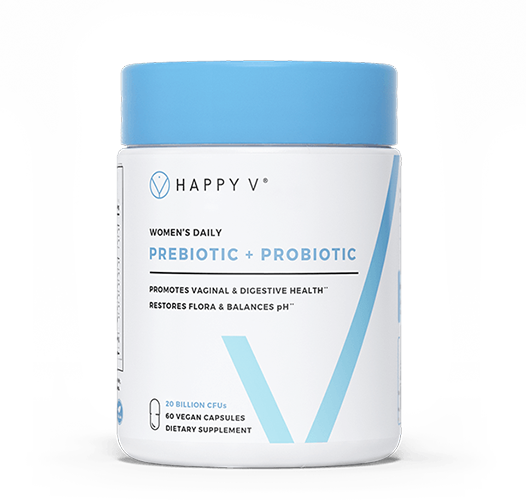- The vaginal microbiome is incredibly sensitive. Many things can cause potential vaginal pH imbalance, not just infidelity.
- The most common culprits for vaginal pH imbalance include poor vaginal hygiene, use of antibiotics, pregnancy, contraception, unprotected sex, and menopause.
- For many people, the first sign of a vaginal pH imbalance is a vaginal infection like BV or a vaginal yeast infection.
- If you ever suspect a vaginal infection, contact your healthcare provider.
- A daily probiotic can help restore your vaginal pH and prevent future infections.

Can a vaginal infection ever be a red flag? Like, if you’re in a committed relationship and suddenly develop a vaginal pH imbalance that leads to a yeast infection or bacterial vaginosis, could this be a sign that your partner is cheating?
The good news is pH imbalances and vaginal infections are not necessarily a sign of cheating. Now, there is a link between abnormal vaginal pH and sexual activity, which we’ll get into later. But before you start updating your Hinge profile, keep reading.
What is vaginal pH?

Your vaginal pH balance is a little number that gives great insight into your overall vaginal health. If your vaginal pH is balanced, that indicates there are enough Lactobacillus in the vaginal microbiome to produce lactic acid lactic acid and prevent the growth of bad bacteria.
But the vaginal microbiome is delicate, and even slight changes in routine or lifestyle can lead to changes in vaginal pH, killing off that Lactobacillus and allowing bad bacteria to take hold. This often leads to vaginal infections like bacterial vaginosis (BV) and vaginal yeast infections.
What are the most common causes of vaginal pH imbalance?

The most common culprits of vaginal pH imbalance include:
1. Using scented vaginal soaps, cleansers, or lubricants
Though these products often smell amazing, those smells are created by chemicals that, when they come in contact with your vagina, can alter your vaginal pH levels. They can also irritate your vaginal mucosa, or the mucus membrane of the vagina, which puts you at increased risk of vaginitis.
2. Vaginal douching
Douching is the cleaning of the vagina using water or other cleansers. And healthcare providers advise against it. That’s because the vagina is actually self-cleaning, and flushing the vagina can disrupt the vaginal microbiome, leading to pH issues.
3. Use or overuse of antibiotics
It’s not uncommon to develop a yeast infection after a course of antibiotics. That’s due to the way broad-spectrum antibiotics actually fight bacterial infections. They don’t just target the bad bacteria causing the infection. They kill all the bacteria in your body, including the good bacteria Lactobacillus, which is responsible for maintaining vaginal pH.
4. Your menstrual cycles
Menstrual blood is slightly alkaline, which means it temporarily raises your vaginal pH. There’s not much you can do to prevent this, but forgetting to change your tampon or pad frequently, like every 2-3 hours, can prevent this temporary rise in pH from becoming not-so-temporary.
5. Menopause
Most people know estrogen is a part of women’s health but don’t necessarily know what it does. Estrogen promotes glycogen production, which keeps the vagina lubricated through normal vaginal discharge. During menopause, estrogen levels fall. This can diminish vaginal discharge and overall lubrication, leading to a gradual imbalance in vaginal pH.
6. Contraception
If you are using a copper intrauterine device, or IUD, to prevent pregnancy, this can disrupt your vaginal pH balance.
7. Pregnancy
Pregnant women experience hormone fluctuations and weakened immune systems, the combination of which makes you more prone to pH imbalance and vaginal infections.
None of these apply to me. Does that mean my partner is a cheater?!

So you don’t douche, you aren’t using IUDs, you aren’t pregnant… but you have an imbalance vaginal pH. The next risk factor to consider is sex and sexual activity, not necessarily your sexual partner’s fidelity.
Having penetrative sex, in general, can affect your vaginal pH level. But some further sex-related risk factors include:
1. Unprotected sex
Semen temporarily raises your vaginal pH levels for 10-14 hours after penetrative sex to create a more favorable environment for sperm to swim. Frequent, unprotected sex can lead to a disruption in vaginal pH balance.
2. Having a female sexual partner
Believe it or not, despite what we just said about semen, one systematic review showed that bacterial vaginosis affected women with female sexual partners more than those with male sexual partners. Bacterial vaginosis is caused by an overgrowth of bad bacteria, which generally stems from an overall imbalance in pH.
3. Multiple sexual partners or a new sexual partner
Each sex partner introduces a variety of new microbes into your vagina, which can disrupt your natural vaginal microbiome and pH balance. These sex partners can also introduce bacteria that lead to sexually transmitted diseases (STDs) or sexually transmitted infections (STIs), like gonorrhea, genital herpes, HPV, HIV/AIDS, chlamydia, and syphilis.
Dirty or improperly cleaned sex toys
Penetrative sex does not always involve a penis, but anything inserted into the vagina can potentially disrupt the vaginal microbiome. If you use sex toys, make sure you are cleaning them often and properly. Using scented soaps or harsh cleaners on your sex toys can have the same effect as using them on your body, where the chemicals alter your vaginal pH balance.
How do I know if my vaginal pH balance is off?

People usually only know their vaginal pH balance is off when they develop a vaginal infection. The two most common are bacterial vaginosis and a vaginal yeast infection.

Bacterial vaginosis
Bacterial vaginosis, or BV, is one of the most common infections in women’s health, generally affecting women between the ages of 15 and 49. The CDC estimates it affects around 30% of women at least once in their lives, though many experience it more than that. BV is not a sexually transmitted infection or STI, but it is more common in sexually active women.
Generally, the most common symptom of bacterial vaginosis is an unusual vaginal discharge that’s white or gray in color. But other, less common symptoms include:
- Itching or burning sensation around the vulva
- A foul odor, which many describe as fish-like and is more noticeable after sex
- Burning sensation during urination or sex
In 1 out of every 3 cases, BV clears on its own. But if you’re experiencing symptoms like the ones listed above, that’s a sign you should see your healthcare provider for some support. They may suggest you take a high-quality, daily probiotic, or they may prescribe you antibiotics, depending on the severity of the infection.
The last thing you want to do is ignore a BV infection since untreated BV can lead to serious complications, like:
- Increased risk of contracting STDs
- Pelvic inflammatory disease (PID)
- Increased risk of infections after any surgery on your genitalia
For pregnant women, untreated BV can also lead to early labor or preterm birth.
Vaginal yeast infections
Vaginal yeast infections, also referred to as vaginal candidiasis, vulvovaginal candidiasis, or candidal vaginitis, are the second most common vaginal infection after BV.
Like BV, symptoms include abnormal vaginal discharge, though the vaginal discharge with yeast infections tends to be thick, white, and cottage cheese-like. Unlike BV, this discharge is also odorless. Other symptoms include:
- Itching or soreness around the vulva
- Redness and swelling of the vulva
- Burning sensation while urinating
Vaginal yeast infections require a visit to your doctor. They might suggest you buy an over-the-counter antifungal, or they may prescribe one to you, depending on the severity of the infection.
How can I maintain a healthy vaginal pH?

Once you’ve treated any infections stemming from poor pH balance, you want to think about how you can maintain a healthy vaginal pH to prevent infections from coming back.
For starters, practice good vaginal hygiene. This involves washing your vulva with mild, unscented soap and peeing every time you have sexual intercourse to help flush out any harmful bacteria that were introduced during sex.
Other things you can do include:
- Avoiding douching
- Use a condom or dental dam during sex
- Wearing breathable, cotton underwear
- Maintaining regular appointments with a gynecologist and healthcare professional
And if you are experiencing frequent infections, incorporating a probiotic into your daily routine can be helpful. Just make sure to buy one that contains clinically proven strains of Lactobacillus, like Happy V’s Prebiotic + Probiotic, so you can be sure you’re replenishing your good bacteria and restoring your vaginal microbiome. Recurrent infections are frustrating, but probiotics are an easy, affordable way to help break the cycle.
- Vaginal pH: A measure of the acidity or alkalinity of the vagina, with a balanced pH indicating a healthy vaginal environment dominated by beneficial bacteria like Lactobacillus.
- Lactobacillus: A type of beneficial bacteria in the vaginal microbiome that produces lactic acid to maintain a healthy pH balance and prevent infections.
- Vaginal Microbiome: The community of microorganisms, including bacteria, that inhabit the vagina and contribute to its health.
- Bacterial Vaginosis (BV): A common vaginal infection caused by an overgrowth of harmful bacteria, often resulting from a pH imbalance.
- Vaginal Yeast Infection: Also known as vaginal candidiasis, an infection caused by the overgrowth of Candida yeast, leading to symptoms like itching and abnormal discharge.
- Menopause: The time in a woman’s life when menstrual periods permanently stop, typically causing hormonal changes that can affect vaginal pH.
- Estrogen: A hormone that helps maintain vaginal health by promoting the production of glycogen, which supports Lactobacillus growth.
- Probiotics: Live beneficial bacteria that help maintain or restore a healthy balance in the vaginal microbiome.
- Antibiotics: Medications used to treat bacterial infections, which can disrupt the balance of good bacteria in the body and affect vaginal pH.
- Douching: The practice of washing the inside of the vagina with water or other solutions, which can disrupt the vaginal microbiome and lead to pH imbalance.
- Pelvic Inflammatory Disease (PID): A serious infection of the female reproductive organs that can result from untreated bacterial vaginosis.
- Prebiotic: A substance that promotes the growth of beneficial bacteria in the body, often used in conjunction with probiotics.
- Bacterial Vaginosis, Centers for Disease Control and Prevention (CDC): https://www.cdc.gov/std/bv/stdfact-bacterial-vaginosis.htm. Accessed on June 27, 2023.
- Forcey, D. S., Vodstrcil, L. A., Hocking, J. S., Fairley, C. K., Law, M., McNair, R. P., & Bradshaw, C. S. (2015). Factors Associated with Bacterial Vaginosis among Women Who Have Sex with Women: A Systematic Review. PloS one, 10(12), e0141905. https://doi.org/10.1371/journal.pone.0141905
- Lin, Y. P., Chen, W. C., Cheng, C. M., & Shen, C. J. (2021). Vaginal pH Value for Clinical Diagnosis and Treatment of Common Vaginitis. Diagnostics (Basel, Switzerland), 11(11), 1996. https://doi.org/10.3390/diagnostics11111996
- Meena V, Bansal CL. Study to Evaluate Targeted Management and Syndromic Management in Women Presenting with Abnormal Vaginal Discharge. J Obstet Gynaecol India. 2016;66(Suppl 1):534-540. doi:10.1007/s13224-016-0879-x. https://www.ncbi.nlm.nih.gov/pmc/articles/PMC5016465/
- Menstrual Hygiene. Centers for Disease Control and Prevention. https://www.cdc.gov/hygiene/personal-hygiene/menstrual.html . Accessed November 24, 2023
- A-
- A+





